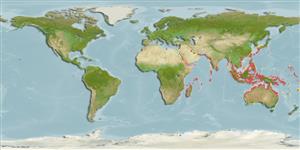Common names from other countries
>
Gobiiformes (Gobies) >
Microdesmidae (Wormfishes) > Ptereleotrinae
Etymology: Parioglossus: Greek, pareia = jaw + Greek, glossa = tongue (Ref. 45335).
More on author: Herre.
Environment: milieu / climate zone / depth range / distribution range
Ecologia
marino; salmastro associati a barriera corallina; distribuzione batimetrica ? - 10 m (Ref. 48637). Tropical
Indo-West Pacific.
Size / Peso / Age
Maturity: Lm ? range ? - ? cm
Max length : 3.5 cm SL maschio/sesso non determinato; (Ref. 48637)
Short description
Chiavi di identificazione | Morfologia | Morfometria
Spine dorsali (totale) : 6 - 7; Raggi dorsali molli (totale) : 16 - 19; Spine anali: 1; Raggi anali molli: 16 - 19.
Inhabits lower reaches of rivers and sheltered reefs (Ref. 37816). Found in small groups on silty reefs to about 10 meters depth (Ref. 48637).
Life cycle and mating behavior
Maturities | Riproduzione | Spawnings | Egg(s) | Fecundities | Larve
Kailola, P.J., 1991. The fishes of Papua New Guinea: a revised and annotated checklist. Vol. III. Gobiidae to Molidae. Research Bulletin No. 41, Research Section, Dept. of Fisheries and Marine Resources, Papua New Guinea. 153 p. (Ref. 6771)
IUCN Red List Status (Ref. 130435)
CITES (Ref. 128078)
Not Evaluated
Threat to humans
Harmless
Human uses
Strumenti
Special reports
Download XML
Fonti Internet
Estimates based on models
Preferred temperature (Ref.
115969): 24.7 - 29.3, mean 28.5 (based on 2531 cells).
Phylogenetic diversity index (Ref.
82804): PD
50 = 0.5000 [Uniqueness, from 0.5 = low to 2.0 = high].
Bayesian length-weight: a=0.00389 (0.00180 - 0.00842), b=3.12 (2.94 - 3.30), in cm Total Length, based on all LWR estimates for this body shape (Ref.
93245).
Trophic level (Ref.
69278): 3.2 ±0.4 se; based on size and trophs of closest relatives
Fishing Vulnerability (Ref.
59153): Low vulnerability (10 of 100).
